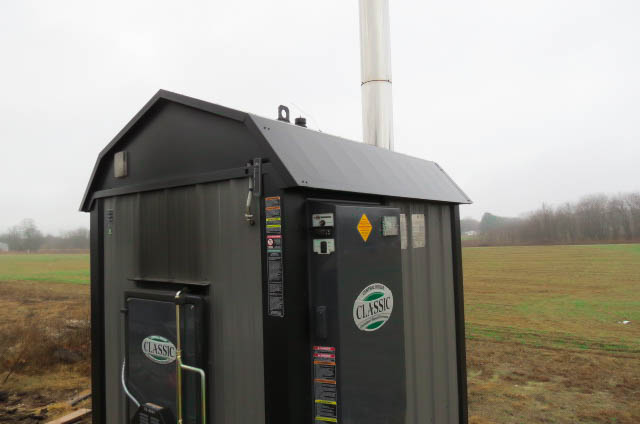Exterior wood burning and corn burning furnaces and boilers
 Exterior wood burning and corn burning furnaces and boilers
Exterior wood burning and corn burning furnaces and boilers
 Exterior heating units, like all interior heating systems within buildings Grinnell Mutual insures or reinsures, must be tested, listed, and approved by a nationally recognized organization following established recognized safety standards such as the UL 391 is the Solid Fuel Burning Standard). Nationally recognized organizations include UL, CSA International, and Warnock Hersey.
Exterior heating units, like all interior heating systems within buildings Grinnell Mutual insures or reinsures, must be tested, listed, and approved by a nationally recognized organization following established recognized safety standards such as the UL 391 is the Solid Fuel Burning Standard). Nationally recognized organizations include UL, CSA International, and Warnock Hersey.
The unit must be specifically designed for exterior installations (installing a heating system that was designed, tested, listed, and/or approved for interior installation outside of a building or enclosure is not acceptable).
The heating system should be installed in accordance with the manufacturer’s recommendations with regards to clearances from combustible buildings or structures.
Exterior heating units, like all heating appliances, should be used only to burn the type of fuels recommended by the manufacturer. Heating appliances are tested, listed, and/or approved to burn only specific types of fuel such as seasoned firewood or shelled corn.
Exterior heating appliances, should be vented in accordance with the manufacturer’s recommendations. Unlisted single-wall steel pipes are not an acceptable method of venting any interior or exterior heating appliance at a one- or two-family residential property, based on NFPA 211 (National Fire Protection Association Standard for Chimneys, Fireplaces, Vents, and Solid Fuel Burning Appliances).
Venting solid-fuel-burning heating units
Outdoor wood burning heating units
Wood burning heating units should be vented to:
- A factory-built chimney which has been tested and approved to UL 103 or UL 103HT Standards
- A clay-tile-lined masonry chimney
Outdoor corn burning appliances
Corn burning appliances should be vented into one of three types of chimneys or vents:
- Type “L” vent
- Factory-built chimney tested and approved to UL 103 or UL 103 HT Standards
- Clay-tile-lined masonry chimney
Installing a heating appliance chimney
All heating appliance chimneys should be installed following the 10 foot, 2 foot, 3 foot rule:
- The chimney or vent pipe must penetrate the roof of the building or enclosure and extend 3 feet above the roof line.
- The chimney or vent pipe should extend a minimum of 2 feet above the roof ridge or any part of the roof within 10 feet of the chimney or vent pipe.
For example, if an exterior heating appliance was located less than 10 feet from the exterior of a one story or two story building, the vent or chimney on the exterior unit would be required to extend 2 feet above the roof of the main building within 10 feet of the chimney or vent pipe.
Installation requirements for exterior furnaces and boilers
If mechanical work is being performed within the building
If mechanical work is being performed within residential garage, machine shed, or commercial building, installation requirements differ.
Exterior forced-air furnace installation requirements:
- Hot air ducts into the building should terminate not less than 8 feet above the floor
- Air for combustion should be obtained from the exterior of the building, NOT from the building being heated.
Exterior hot water boiler installation requirements:
- Hot water pipes may be located at or within the floor. Radiators and convectors may be located at any height above the floor.
If no mechanical work is being performed within the building and there is no storage or transfer of flammable or combustible liquids
Installation requirements are different if no mechanical work is being performed within the building and there is no storage or transfer of flammable or combustible liquids within the building.
Exterior forced-air furnace installation requirements:
- Heat ducts into the building may be located at floor level
- Air for combustion should be obtained from the exterior of the building
Exterior hot water boiler installation requirements:
- Hot water pipes entering the building may be located at floor level
Maintenance of exterior heating appliance
The exterior heating appliance and chimney/vent pipes of the exterior unit must be maintained and cleaned in accordance with the manufacturer’s recommendations, or at least on an annual basis by a professional chimney sweep.
For more information
If you are uncertain if a specific unit is listed or approved, please contact the Grinnell Mutual’s Loss Control Department or the local Loss Control representative in your area with the heating appliance manufacturer’s name, the model number for the unit, and the manufacturer’s phone number or website address.
Download "Exterior wood burning and corn burning furnaces and boilers" Read more loss control materials Learn about our insurance coverages
This bulletin has been prepared as an underwriting reference for members of Grinnell Mutual Reinsurance Company and does not signify approval or disapproval by the Company of any product or device. Please do not copy or reproduce any portion of this bulletin without the written permission of Grinnell Mutual Reinsurance Company. The information included in this publication and program was obtained from sources believed to be reliable, however Grinnell Mutual makes no guarantee of results and assumes no liability in connection with its use. It is the user’s responsibility to comply with any applicable regulations or laws. Information obtained from or via Grinnell Mutual should not be used as the basis for legal advice, but should be confirmed with alternative sources.